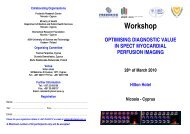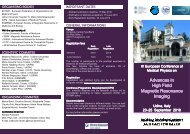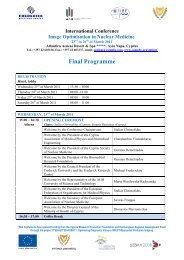medical physics international - Cyprus Association of Medical ...
medical physics international - Cyprus Association of Medical ...
medical physics international - Cyprus Association of Medical ...
- No tags were found...
Create successful ePaper yourself
Turn your PDF publications into a flip-book with our unique Google optimized e-Paper software.
MEDICAL PHYSICS INTERNATIONAL Journal, vol.1, No.1, 2013Figure 4. The relationship <strong>of</strong> the various radiation dosequantities used in CT.LEARNING AND TEACHING PHYSICSA. Classroom and Conference Presentation.Both <strong>of</strong> these obstacles can be overcome to a greatextent by the use <strong>of</strong> the web-based resources providedhere. These are visuals for classroom/conferencepresentations and discussions (Ref. 1) and a module (Ref.2) to support both classroom learning and as a review andreference during clinical activities.The Visuals can be used by <strong>medical</strong> physicists, evenwithout significant CT experience, to conduct classes andconference discussions on the <strong>physics</strong> that is thefoundation <strong>of</strong> CT. They are used in the context <strong>of</strong>Collaborative Teaching where the physicist conductingthe class or conference discussion uses his knowledge andexperience in general and radiation <strong>physics</strong> incombination with the Visuals prepared by a collaborator,in this case the author, who has extensive experience inthe <strong>physics</strong> <strong>of</strong> clinical CT. A significant value <strong>of</strong> thevisuals is that they provide a highly-effective connectionbetween the classroom and the clinical CT process. Itenables the learners to develop mental knowledgestructures that will support their clinical activities,specifically analyzing images and optimizing procedures.The online module can be assigned to the learners,rather than a traditional textbook, for additional study,review, and reference.LEARNING PHYSICS IN THE CLINICFigure 5. The series <strong>of</strong> learning activities that contributes to<strong>physics</strong> knowledge that can be applied to clinical imaging.Knowledge <strong>of</strong> <strong>physics</strong>, and especially <strong>medical</strong><strong>physics</strong>, is developed through a series <strong>of</strong> learningactivities ranging from classroom to direct clinicalexperience as shown here.A major objective <strong>of</strong> <strong>medical</strong> <strong>physics</strong> education for<strong>medical</strong> imaging pr<strong>of</strong>essionals is to enable them to apply<strong>physics</strong> principles in the control and optimization <strong>of</strong> theimaging process, such as CT. The different types <strong>of</strong>learning activities have their advantages and values butalso their limitations and challenges. The goal is toprovide a combination <strong>of</strong> activities that produce thedesired results.The clinical environment where the learner is actuallyparticipating in CT procedures provides an excellentopportunity for learning <strong>physics</strong>. The great advantage <strong>of</strong>this, compared to the traditional classroom is that there isdirect observation and interaction with the equipment, theimages, and the procedures. Here the learning experiencecan be directed by the experienced clinical radiologyfaculty. The online module is used as a review as thelearner begins a clinical CT rotation and as a reference asquestions come up and during discussions with theclinical faculty.While it is important to produce images <strong>of</strong> superiorquality, it is also important for trainees to understand thecost <strong>of</strong> radiation dose when evaluating CT images.Despite the increased focus on radiation dose, fewradiologists routinely examine the CT dose report onevery patient, especially when the images are <strong>of</strong> goodquality. It is important that radiology trainees be aware<strong>of</strong> the principle <strong>of</strong> As Low As Reasonably Achievable(ALARA). While images should be <strong>of</strong> diagnostic quality,some noise should be expected for most exams if theradiation dose is considered. Discussing the dose reportroutinely raises awareness <strong>of</strong> CT dose and its relationshipto image quality and also reinforces concepts <strong>of</strong> CTDIvol,DLP, and effective dose with the increasing complexity<strong>of</strong> newer scanners.48






